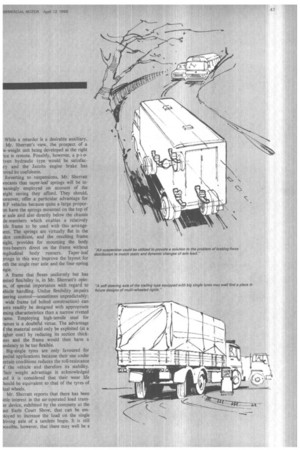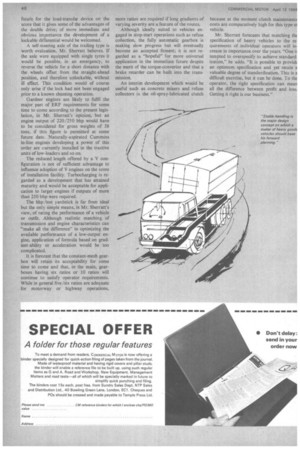MR. SHERRATT cites stable handling as the major design concept
Page 48

Page 49

Page 50

If you've noticed an error in this article please click here to report it so we can fix it.
on which a maker of heavy goods vehicles should base his forward planning. And he emphasizes that implementing this concept will increasingly involve "looking at the vehicle as a whole with appropriate attention to detail.
Constant effort is needed to improve the "ride" characteristics of the vehicle and distt ibution of braking force to match static and dynamic changes of axle load is regarded by Mr. Sherratt as the most outstanding stability problem in need of solution. He considers that air suspension could be used to provide a practical solution in addition to other benefits. It could enable distribution to be more exactly controlled than is possible with a conventional brake -load apportioning system and could eliminate the need for a non-locking system. In particular it could be applied with benefits to an articulated outfit.
In Mr. Sherratt's scheme, the air suspension oircuit would have brake control valves which would vary the air pressure of the service brake actuators in accordance with changes of air pressure in the bellows, which is a function of dynamic as well as static changes of load. The braking system of an attic fitted with air suspension at the driving axle or axles of the tractive unit and the semi-trailer axle or axles could readily be designed to give brake apportioning that was immediately responsive to load changes.
While acknowledging the potential merits of a non-locking system applicable to all wheels, Mr. Sherratt does not consider that the flywheel overrun type or an electronic system based on tacho-generators has a future. In his opinion the flywheel-overrun system is too complicated and costly for commercial applications and electronic devices can be too susceptible to condensation troubles and so on for use as standard equipment on commercial vehicles operating in all weathers.
The problem of obtaining good suspension characteristics when air suspension is applied to a long wheelbase rigid vehicle (or tractive unit) beefiuse of frame flexing could, in Mr. Sherratt's opinion, be overcome by the use of an anti roll bar or linkage to give the same effect As demonstrated by applications to semi trailers. air suspension would reduce maintenance costs (and possible tyre wear) and with further development could reduce the unladen weight of the vehicle.
Progress over the years in the design and development of air suspension has eliminat ed its earlier deficiencies. It would also offer an easy means of providing an axle load sensing system with dials in the cab.
On the subject of foundation brakes. Mr. Sherratt points out that recent improvements in actuator systems and the increased braking power they provide have highlighted the need for precision in the operation of the shoes and for linings of unvarying friction-coefficient. The design and production of foundation brakes should be such that "discrepancies" in the mechanisms are eliminated and operation is not affected by small amounts of wear.
He forecasts that the wedge brake system will make a comeback because it is more efficient and enables smaller and lighter air actuators and reservoirs to be employed on account of the reduced consumption of air that its use involves.
So far the design of heavy duty disc brakes have not been fool-proof, says Mr. Sherratt, but they might have a future if original equipment and maintenance costs were more favourable. Over 50 ERF vehicles (mostly eight-wheelers) have been fitted with disc brakes at the front and Mr. Sherratt has made a very close study of performance factors. He notes that with hydraulically operated front brakes (air assisted) and air-operated cam rear brakes the characteristic action of the front disc brakes (and slight normal delay in the application of the rear brakes) give a favourable braking performance, although it would have been interesting to compare the results with wedge-operated rear brakes.
Spring brakes cannot be abused and they can be adjusted to give the rated performance with the spring fully extended; and of course a reliable self adjustor would be an asset to the installation, Mr. Sherratt points out In a lock actuator there are more parts that can go wrong or wear out and thus adversely affect the efficiency of operation. The adaptability of a spring brake for use in the secondary system is an added advantage.
While a retarder is a desirable auxiliary,
Mr. Shenatt's view, the prospect of a w-weight unit being developed at the right ice is remote. Possibly. however, a p t oiven hydraulic type would be satisfacTy and the Jacobs engine brake has -oved its usefulness.
Reverting to suspensions, Mr. Sherratt ■ recasts that taper leaf springs will be ineasingly employed on account of the eight saving they afford. They should. .oreover, offer a particular advantage for RF vehicles because quite a large proporan have the springs mounted on the top of te axle and also directly below the chassis de-members which enables a relatively ide frame to be used with this arrange tent. The springs are virtually flat in the ,den condition, and the resulting frame tight, provides for mounting the body ross-bearers direct on the frame without
mgitudinal bodyrunners. Taper-leaf distribution to match static and dynamic changes of axle load."
'rings in this way improve the layout for
oth the single rear axle and the four spring
ogie.
A frame that flexes uniformly but has mited flexibility is, in Mr. Sherratt's opin)n of special importance with regard to ehicle handling indue flexibility impairs Leering control—sometimes unpredictably:
wide frame (of bolted construction) can lore readily be designed with appropriate exing characteristics than a narrow riveted flame. Employing high tensile steel for 7arnes is a doubtful virtue. The advantage V the material could only be exploited (at a igher cost) by reducing its section thickess and the frame would then have a endency to be too flexible.
Big stogietyres are only favoured for pectal applications because their use under ertain conditions reduces the roil-resistance if the vehicle and therefore its stability. -heir weight advantage is acknowledged :rid it is considered that their wear life hould be equivalent to that of the tyres of lual wheels.
Mr. Sherratt reports that there has been ittle interest in the air operated load transer device, exhibited by the company at the ast Earls Court Show, that can be em)loyed to increase the load on the single irisring axle of a tandem bogie. It is still mssible, however, that there may well be a futufe for the load-transfer device on the score that it gives some of the advantages of the double drive; of more immediate and obvious importance the development of a lockable differential would be welcomed.
A self steering axle of the trailing type is worth evaluation, Mr. Sherratt believes. If the axle were equipped with single tyres it would be possible, in an emergency, to reverse the vehicle for a short distance with the wheels offset from the straight-ahead position, and therefore unlockable, without ill effect. This condition would of course only arise if the lock had not been engaged prior to a known shunting operation.
Gardner engines are likely to fulfil the major part of ERF requirements for some time to come according to the present legislation, in Mr. Sherratt's opinion, but an engine output of 220/250 bhp would have to be considered for gross weights of 38 tons, if this figure is permitted at some future date. Naturally-aspirated Cumrnins in-line engines developing a power of this order are currently installed in the tractive units of low-loaders and so on.
The reduced length offered by a V configuration is not of sufficient advantage to influence adoption of V engines on the score of installation facility. Turbocharging is regarded as a development that has attained maturity and would be acceptable for application to larger engines if outputs of more than 250 bhp were required.
The bhp /ton yardstick is far from ideal but the only simple means, in Mr. Sherratt's view, of rating the performance of a vehicle or outfit. Although realistic matching of transmission and engine characteristics can "make all the difference" in optimizing the available performance of a low-output en gine. application of formula based on gradient-ability or acceleration would be too complicated.
It is forecast that the constant-mesh gearbox will retain its acceptability for some time to come and that, in the main, gearboxes haying six ratios or 10 ratios will continue to satisfy operator requirements. While in general five /six ratios are adequate for motorway or highway operations, more ratios are required if long gradients of varying severity are a feature of the routes.
Although ideally suited to vehicles en gaged in stop-start operations such as refuse collection, the fully automatic gearbox is making slow progress but will eventually become an accepted fitment; it is not regarded as a "hopeful" for more universal application in the immediate future despite the merit of the torque-convertor and that a brake retarder can be built into the transmission.
An interim development which would be useful such as concrete mixers and refuse collectors is the oil-spray-lubricated clutch because at the moment clutch maintenance costs are comparatively high for this type of vehicle.
Mr. Sherratt forecasts that matching tin specification of heavy vehicles to the requirements of individual operators will increase in importance over the years. "One it tempted to overspecify to achieve standard ization," he adds. It is possible to provide an optimum specification and yet retain a valuable degree of standardization. This is a difficult exercise. but it can be done. To tlw operator, the right specification can mean all the difference between profit and loss. Getting it right is our business."




































































































